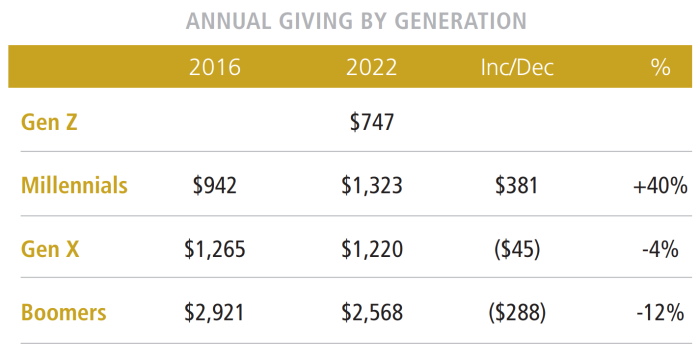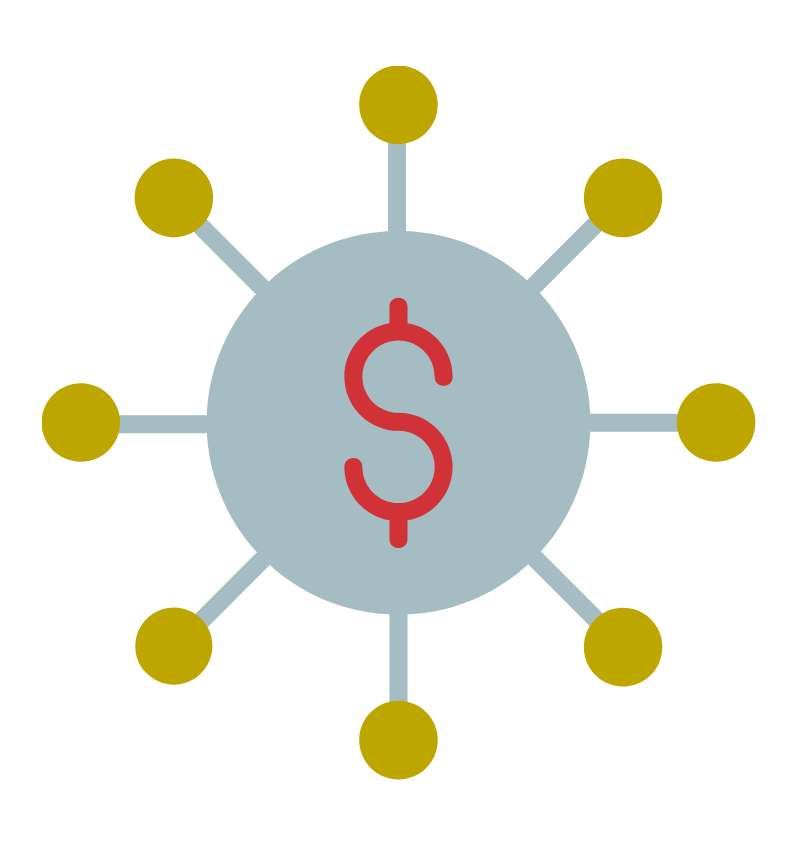As times change, so too do donor demographics. As generations mature and a greater number of younger donors enter the giving pool, increasing both by number and gift capacity, giving trends continue to shift and evolve. The next generation of donors—Gen X, Millennials, and even Gen Z—will dictate the future of philanthropy. As such, it’s essential to understand what motivates and drives younger donor groups, as well as how to work to implement successful campaigns to engage and build relationships with these groups.
An Emerging New Generation of Donors
According to The Giving Institute and their special report, Giving By Generation, among younger donor groups, Millennials, in particular, are emerging as an influential body. Millennials are the one generational group that has most significantly increased their giving over the years 2016 to 2022, showing an increase in average household charitable giving by a staggering 40%. By contrast, during the same time period, Gen X showed a decrease in annual household giving by 4% and Baby Boomers showed a decrease in average household giving by approximately 12%.

Average Household Giving by Generation
A Shift in Giving Trends
Millennials are not only increasing the amount they give, they are shifting the narrative on how young people give and why and how they become engaged with organizations. As Giving By Generation notes, Millennials are more likely than other groups to seek a hands-on approach to supporting an organization and dedicate hours of their time to volunteering. More and more they’re seeking a seat at a table, or at least seeking out organizations that show both transparency and a desire to understand the concerns of their donors.
Where Millennials give is also worth noting. While places of worship continue to be the most prominent recipients of charitable giving across generations, Millennials are more involved in faith-based giving than other generations. (Worth nothing: only Gen Z as a whole currently prioritizes giving to environmental causes over faith-based organizations.)
As Millennials emerge as a significant donor group, it’s clear that their giving habits are influencing generations beyond their own. Studies show that Millennials donors are highly incentivized to give when there is the possibility of a matching or multiplying donation. While this group, as well as Gen Z, is highly “plugged in” to technology, donors across the board, including Gen X and Baby Boomers, are also overwhelmingly giving through various online platforms. Today as many as 38% of donors report giving to an organization through their smartphone or tablet, and 47% of both Millennials and Gen Z donors report giving through a QR code. Text-to-give campaigns have also received a small but steady growth in response rate from 1% in 2016 to 7% in 2022.
3 Ways to Engage Younger Donors
Understanding that young donors, and particularly Millennials, are important to current and future philanthropy is the first step. But how do you go about engaging this group? Whether your organization wants to broaden and deepen a young donor commitment, or perhaps begin from the ground up, it can be a daunting prospect. Here are three ways to begin to think about engaging younger donors:
1) Make Giving Accessible
The data shows the young donors want options when it comes to giving. Meet donors where they are and work to make donating as easy and accessible as possible. Not only does your website needs to be clear and user-friendly, it needs to be mobile-compliant. Create the option for donors to be able to give through social media, and where applicable, through QR codes.

Example of contactless donations via QR code
For any events, consider experimenting with text-to-give campaigns. Organizations are increasingly moving in this direction with success. For Emma Mendenhall, a Philanthropy and Stewardship Officer with Planned Parenthood of Arizona (PPAZ), creating a strong young donor network has been crucial. One of her organization’s greatest successes in mobilizing younger donors has been “to meet the younger population where there are, both physically and philanthropically.” In the case of PPAZ, that means both involving the community and optimizing technology. “We recently held an event at a popular local bar and had QR code signage set out across the event, and a text-to-give line set up, and didn’t even need to have a formal ask to see gifts come in.” Creating multiple possibilities for giving only increases an organization’s potential touchpoints with both established donor communities and potential new supporters.
2) Create a Junior Board
Millennials are hungry to engage with organizations in a meaningful way. Creating a Junior Board is one way to bring together a highly motivated group of young people that can evolve over time to be key trustees. Katie Steinbach, the Director of Development of Harlem Academy, a Kindergarten through 8th grade school in Upper Manhattan that serves children from underserved backgrounds and fundraises the majority of the tuition for the school’s students, formed a Junior Board that has become essential to the overall fundraising strategy. From its creation six years ago to today, the Junior Board (of which all members are individuals in their 20s and 30s) went from raising $5,000 to $300,000 annually. Steinbach thinks of the Junior Board as the next generation of trustees as well as a mutually beneficial relationship. As she points out, “Members benefit from being involved with us and they learn about what it’s like to join a board. They get connected to a really awesome organization, and hopefully, if I’m doing my job well, it’s really fulfilling. They have direct access to working with kids, volunteering in a way that I think a lot of young people are looking for outside of their day jobs. There’s an emotional, fulfilling component to it.”
3) Foster Authentic Connection
The emotional, fulfilling aspect Steinbach speaks of is important to engaging younger donors and should not necessarily be hampered by financial capacity. Many of Harlem Academy’s Junior Board members began as volunteers before evolving into donors and connectors. Creating an option for involvement that does not necessarily translate to a direct gift is essential in forming authentic relationships with younger donors. Some volunteers might lend invaluable help with tangible needs for your organization, such as staffing events. Other might help create connections to individuals and communities with gift capacity. It’s important to honor and respect everything people can bring to the table and that has never been truer than with young donors.
While Steinbach points out that fundraising is the main piece of working with donors, she also seeks participation, ideas, and volunteering. Involvement, she says, “looks different for different people. Someone might make a connection to a boss and bring in a corporate partnership. Other people might host a get together at their homes and invite 20 friends and a couple of people give small gifts and that’s great too.”
For Emma Mendenhall with PPAZ, creating authentic connection has meant building a community of not just donors, but local vendors and the community at large as well. Following the SCOTUS decision to overturn Roe v. Wade, PPAZ saw their community turn out in support of the organization and with a desire to be part of the effort to make a tangible difference. “We created an event where we heard lots of comments about how good it felt to be in community with like-minded folks, to see local vendors who were supporting the same causes they felt passionate about, and lots of inquiries about ‘how can I help’ that included giving but went beyond to engaging volunteers and strengthening community partnerships.”
Like all aspects of fundraising, it’s the relationship, and the human connection, that ultimately inspires involvement and a sustained commitment to a mission.



